|
THE CARTRIDGE COLLECTOR'S EXCHANGE |
| Contents
Cartridge
Lists
Prior Picture Pages:
Links to Other Sites
Cartridge Collectors Organizations:
Auctions:
Books:
Other Collector's Sites:
|
Home of the Old Ammo Guy's Virtual
Cartridge Trading Table
Picture Page May 2010 A UMC .44-40 box to watch out for (or beware of)......
This box recently showed up on the International Ammunition Association's cartridge forum. Cartridge box collectors haven't had to give much thought in the past to fakes when dealing in boxes produced after 1900 by the major US commercial manufacturers. About the worst thing you might have encountered would incorrect cartridges or a mix of cartridges in a box. There doesn't appear to be a problem with the cartridges in this box, nor with the box itself, but the labels are another matter. With the high prices being paid for even common caliber collector-grade two piece boxes made by such companies as Winchester, Remington-UMC, and the Unites States Cartridge Company, it had to follow that unscrupulous individuals who have a tough time making an honest living would soon begin to make their presence known to collectors of post-1900 boxes. This box points out the need for collectors to look much more closely at any box they are considering purchasing.. There are a lot of indicators that the labels on this box are not correct - actually,
an overwhelming number. However, if not looked at carefully, and without a
box from the same period to compare it to, a beginning collector or even a
seasoned one could easily The top label looks good at first glance; there are some formatting and spacing differences, but these might be expected from one label printing to the next. However, note that the cartridge on the label of the suspect box has a REM-UMC headstamp, which would be expected on a box made after the merger of Remington Arms and UMC, but not on a box made prior to the merger. In addition, the cartridge on the label appears to have a neck cannelure, which would indicate it is a smokless load, yet the '40 GRS POWDER' on the label indicates the cartridges are black powder loads. The side sealing label displays a number of problems. Of interest are the firearms noted on one end of the box, the 'New Lightning Magazine Rifle and Frontier Revolver'. The inclusion of these Colt firearms on the label will add significant value to a box of .44-40 cartreidges. However, UMC boxes of cartridges that were marketed for the Colt firearms would be expected to have a Colt endorsement of the cartridges on the side label, with a 'Colt Patent Firearms Manufacturing Company' signature. In addition, UMC cartridges for the Lightning Magazine Rifle are quite rare, and are in specially labeled boxes. Further, the cartridge on the top label and those in the box would be expected to have the 'C.L.M.R.' headstamp. Since the top label on the suspect box indicates the cartridges are for the .44 caliber Winchester, I would expect the side label to reflect this also, as seen on the 'correct' box.
. . . . . .
. . . .
A box of UMC .32 Long Rifle rim fire cartridges....
It is interesting to note that, while the inside lubed bullet was being used by the U.S. military as early as the 1860s for many of the rim fire cartridges, it took until the mid 1890s for some of the popular commercial rim fire and center fire cartridges to make the transition from outside lubed to inside lubed bullets. The .32 Long Rifle was introduced around 1900 as an inside lubed improvement to the .32 long rim fire. The case was a little longer than the .32 long, but otherwise, the dimensions were about the same. Both UMC and Winchester added the .32 long rifle as a black powder load to their catalogs around 1901; Winchester also produced it as a Lesmok load beginning in 1911. It was no longer listed in either company catalog following the end of World War I. .
. . . .
An interesting DWM headstamp.....
. . .
|

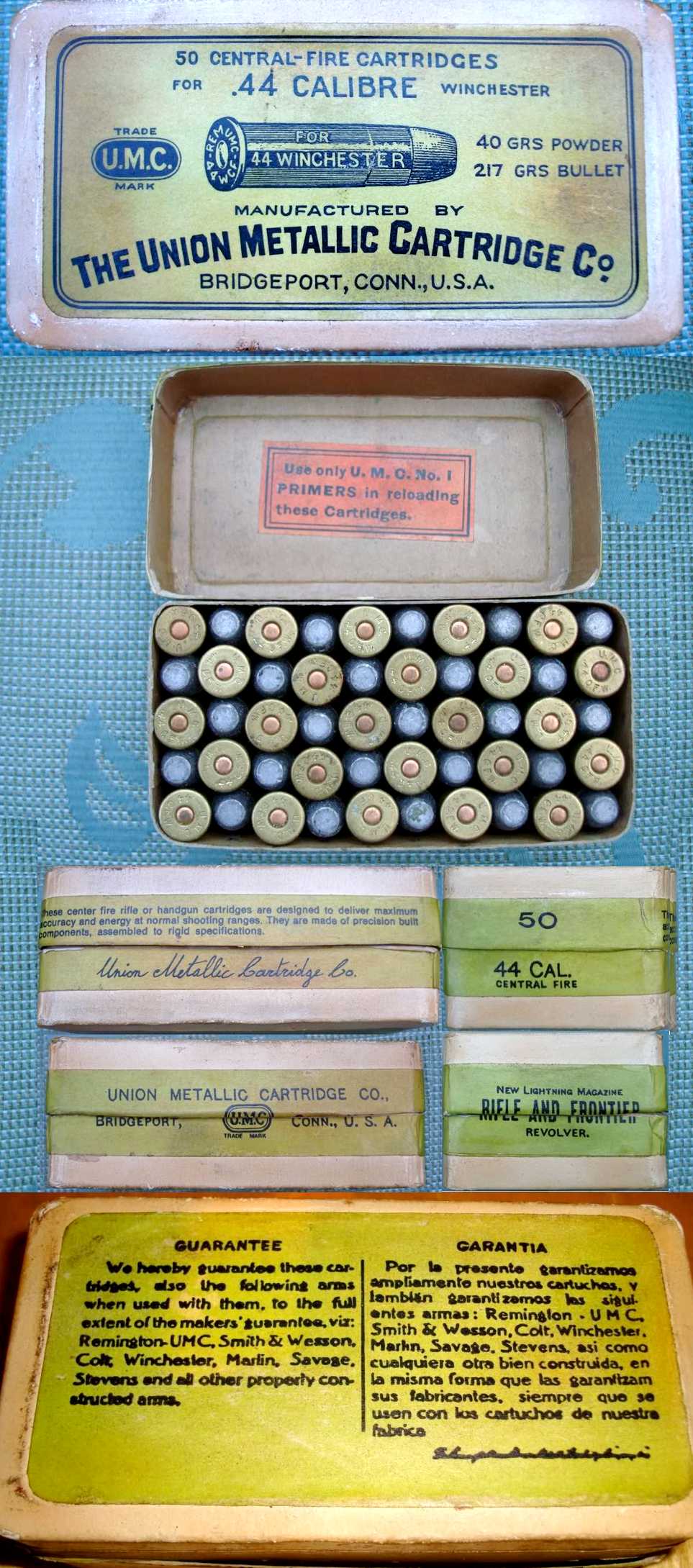 Here's
a box you may want to be on the lookout for, not because it would make a
great addition to your collection, but because it is not everything that it
initially appears to be. At first glance, it looks like a great box - in
very good condition with all of its labels intact, still full of cartridges,
and marked on one end for Colts New Lightning rifle and Frontier revolver.
You could hardly ask for a better combination of firearms to be on the label
for adding collector appeal to a box of cartridges. The more you look at
this box, the more interesting it gets, to the point of being a little
too interesting.
Here's
a box you may want to be on the lookout for, not because it would make a
great addition to your collection, but because it is not everything that it
initially appears to be. At first glance, it looks like a great box - in
very good condition with all of its labels intact, still full of cartridges,
and marked on one end for Colts New Lightning rifle and Frontier revolver.
You could hardly ask for a better combination of firearms to be on the label
for adding collector appeal to a box of cartridges. The more you look at
this box, the more interesting it gets, to the point of being a little
too interesting. The
statement on the side of the suspect box above the UMC signature (shown in
this picture) is very much out of character for this style box. The typical
statement on these UMC boxes is in the form of a guarantee that the
cartridges will function well in a quality firearm, as shown in the second
picture.
The
statement on the side of the suspect box above the UMC signature (shown in
this picture) is very much out of character for this style box. The typical
statement on these UMC boxes is in the form of a guarantee that the
cartridges will function well in a quality firearm, as shown in the second
picture.
 Such
guarantees were dropped as the ammunition industry became more
liability-conscious in the mid 1900s. The wording of the statement on
suspect box provides undeniable proof that the box is not correct, as I
found nearly identical wording on a box of Winchester .44-40 cartridges of
the 'horse and rider' style that was introduced around 1981 after Olin
Corporation had sold the firearms side of its business to the U.S. Repeating
Arms Company.
Such
guarantees were dropped as the ammunition industry became more
liability-conscious in the mid 1900s. The wording of the statement on
suspect box provides undeniable proof that the box is not correct, as I
found nearly identical wording on a box of Winchester .44-40 cartridges of
the 'horse and rider' style that was introduced around 1981 after Olin
Corporation had sold the firearms side of its business to the U.S. Repeating
Arms Company.
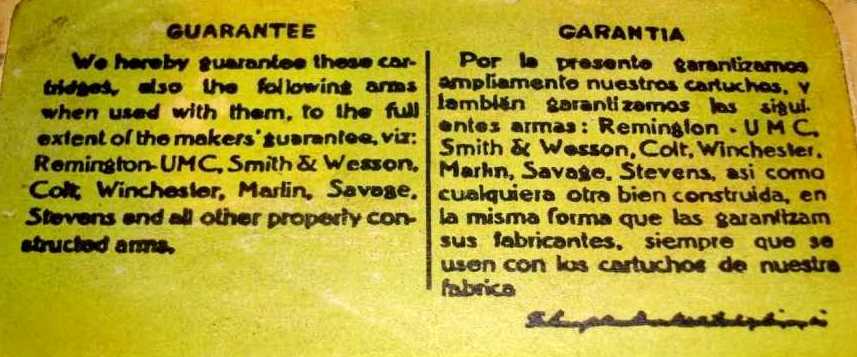 The
guarantee label on the bottom of the suspect box is the bi-lingual (English
and Spanish) style that was usually used on boxes intended for exportation
to Mexico. I am not aware of these bi-lingual labels being used on UMC
boxes; I have only seen them on boxes with the Remington-UMC labels; if
anyone knows otherwise, I'd appreciate hearing from them. The bottom
guarantee label should also include the 'Union Metallic Cartridge Co.'
signature printed on the bottom right-hand side; it should match the style
of the signature on the side of the box, although it will usually
The
guarantee label on the bottom of the suspect box is the bi-lingual (English
and Spanish) style that was usually used on boxes intended for exportation
to Mexico. I am not aware of these bi-lingual labels being used on UMC
boxes; I have only seen them on boxes with the Remington-UMC labels; if
anyone knows otherwise, I'd appreciate hearing from them. The bottom
guarantee label should also include the 'Union Metallic Cartridge Co.'
signature printed on the bottom right-hand side; it should match the style
of the signature on the side of the box, although it will usually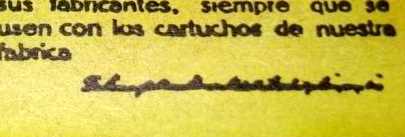 be smaller. The signature on the bottom label of the suspect box is
illegible, but whatever it says, it definitely is not Union Metallic
Cartridge Co.
be smaller. The signature on the bottom label of the suspect box is
illegible, but whatever it says, it definitely is not Union Metallic
Cartridge Co.  The
cartridge shown here is 9.3 x 74R Mauser, made since about 1902 and still
popular today and manufactured by most of the European ammunition makers for
use in drillings and combination guns. The cartridge shown here was made by
Deutsche Werke AG (DWA) in 1920. According to W. B. Dixon (European
Sporting Cartridges), DWA was established in 1919 to run the German
ammunition factories and convert them back over to peace time production.
The
cartridge shown here is 9.3 x 74R Mauser, made since about 1902 and still
popular today and manufactured by most of the European ammunition makers for
use in drillings and combination guns. The cartridge shown here was made by
Deutsche Werke AG (DWA) in 1920. According to W. B. Dixon (European
Sporting Cartridges), DWA was established in 1919 to run the German
ammunition factories and convert them back over to peace time production. 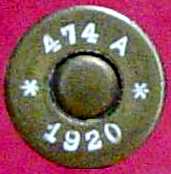 The 474A in the headstamp
is the number assigned to the case by DWM. These case numbers were used only
until a
The 474A in the headstamp
is the number assigned to the case by DWM. These case numbers were used only
until a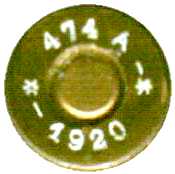 bout 1936. The stars
were included in the headstamps of sporting ammunition by the company
and were dropped about 1920 and replaced by pairs of small letters, one on
either side of the DWM to indicate the date of manufacture. Mr Dixon posted
a variation of this headstamp to the IAA cartridge forum that includes small
dashes next to the stars, shown on the right.
bout 1936. The stars
were included in the headstamps of sporting ammunition by the company
and were dropped about 1920 and replaced by pairs of small letters, one on
either side of the DWM to indicate the date of manufacture. Mr Dixon posted
a variation of this headstamp to the IAA cartridge forum that includes small
dashes next to the stars, shown on the right.